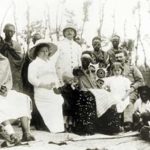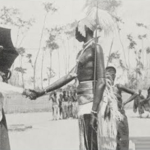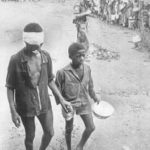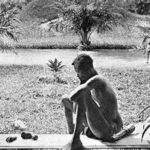Nduga’s Attitudes Toward KINYAGANS
As central chiefs and the royal court moved into Kinyaga the local population became sharply aware of differences between themselves and the haughty courtiers from Nduga, the Rwandan heartland. Attitudes ofNdugans toward Kinyagans ranged from mere disdain to complete mistrust. They noticed different manners among local people and linguistic variations from the Ikinyarwanda spoken in central Rwanda. They considered Kinyagans not only less sophisticated than themselves but dirty, crude, and uncouth as well. Ndugans also feared to eat locally prepared food, not wanting to risk being poisoned. Even Kinyagans who considered themselves solidly Rwandan and Tuutsi were viewed with scom by the Ndugans.
While needing local support for the successful execution of Rwabugiri’s expeditions in the west, Ndugans had little confidence in the Kinyagan population. Nevertheless, Kinyagans played an important part in the Rwandan campaigns against Ijwi and Bushi. People living along the peninsulas of Lake Kivu were (and still are) superb boatmen, and their navigational skill proved critical in transporting and supplying Rwabugiri’s troops. Perhaps most important were the contributions made by Kinyagan spies and guides who were acquainted with the terrain and social and political conditions in the west.
Two residents of Mururu hill, for example, played a key role during an attack against the Shi at Kanywiriri. Before setting out to guide the troops, the two Kinyagan guides were compelled to drink a truth potion (igihango), taking an oath not to betray the Rwandan cause. The guides successfully led Rwabugiri’s troops to the Shi forces, but to no avail. Rwanda suffered a catastrophic defeat, during which several renowned heroes were killed.
Later, some years after Rwanda’s defeat at Kanywiriri, Rwabugiri again took up the campaign against the strongholds of the Shi to the west of the Rusizi River; he was determined to subdue this tenacious people. Rubago son of Nyamunonoka, a Hutu said to be originally from Bukunzi, with kin ties in Bushi but at that time a resident of Mururu in Kinyaga, came forward offering his services to Rwabugiri. Guided by Rubago, Rwabugiri’s forces launched a surprise attack on the Shi camp and managed to capture the (widowed) queen mother and her son.
The frontier position of Kinyaga gave rise to ambiguity of attitudes, both in how Kinyagans viewed central Rwanda, and in the views of Ndugans toward Kinyagans. Ndugan distrust of Kinyagans arose from the region’s distance from central Rwanda (which made close supervision difficult) and the proximity of the region to different cultures in the west (which made the population “different” and therefore suspect). These differences earned Kinyagans the epithet of “Abashi,” a term applied by Ndugans indiscriminately to people from southwestern Rwanda, implying “barbaric” or “uncultured”:
The Banyakinyaga, more than anyone else, were looked down upon and no more needed to be said when the word “bashi” was uttered: the “foreigners from beyond the frontiers”.
ETHNIC DIFFERENTIATION
Thestatebuilding efforts of Rwabugiri heightened awareness of ethnic differences in Kinyaga. With the arrival of Ndugan authorities, lines of distinction were altered and sharpened, as the categories of Hutu and Tuutsi assumed new hierarchical overtones associated with proximity,to the central court—proximity to power. Later, when the political arena widened and the intensity of political activity increased, these classifications became increasingly stratified and rigidified. More than simply conveying the connotation of cultural difference from Tuutsi, Hutu identity came to be associated with and eventually defined by inferior status. It should be noted that there existed many criteria for ethnic identification, among them birth, wealth (especially in cattle), culture, place of origin, physical attributes, and social and marriage ties. It is impossible to single out any one element as the basis for ethnic identity in all situations. But the political salience of membership in one ethnic category or another came to depend on power.
It is probably with this in mind that many Kinyagans trace the first arrival of Tuutsi in the region to the time of Rwabugiri. In fact, Rwandans who owned cattle and would, in central Rwanda, have been considered culturally and socially Tuutsi arrived in Kinyaga in the eighteenth century. But to many Kinyagans, “Tuutsi” is associated with central government power and institutions, and particularly with the exactions of chiefs backed by central government.
Under Rwabugiri, Tuutsi and Hutu became political labels; “ethnicity,” such as it was, came to assume a political importance, determining a person’s life chances and relations with the authorities. With the establishment of European colonial rule in the country, ethnic categories came to be even more rigidly defined, while the disadvantages of being Hutu and the advantages of being Tuutsi increased significantly. Passing from one ethnic category to the other was not impossible, but over time it became exceedingly difficult and, consequently, very rare.
DUAL COLONIALISM
Rwanda’s mountainousterrain and renowned military might shielded this small state from European occupation until late in the nineteenth century. But in a startling intrusion on the kingdom’s previous impregnability, the German Count von Gôtzen traversed Rwanda in 1894, the first European to reach the royal court. Then in mid-1896, a small contingent of Belgian officers with African soldiers arrived to set up a camp in Kinyaga, the first region of Rwanda to experience European occupation. Initially, Rwanda’s rulers attempted to resist by force of arms. When this failed, they later collaborated with the German authorities who established colonial rule in the country from 1898.
There was, however, no single Rwandan “response” to the colonial invasion. Some Rwandans resisted, some collaborated, and many maneuvered to create opportunities from the presence of these foreigners who had clearly come to stay.The colonial apparatus which emerged involved the interaction of two cornplementary systems of power. Through superior force, prestige, and wealth, the colonial authorities persuaded and often coerced the incumbent (Tuutsi) elite to serve as intemediaries for colonial administration, thus establishing a form of indirect rule. But these intermediaries were not mere puppets. While sacrificing much of their former autonomy, Tuutsi chiefs gained new and more effective forms of power. These were weapons, to be used in the statebuilding objectives of the royal court, in political infighting among the powerful, and in the efforts by chiefs to consolidate a position of superiority vis-à-vis the populations over whom they ruled.
Dual colonial rule in Rwanda accommodated efforts of Europeans to build an economically solvent colonial state. It also accommodated the internal goals of various factions among the Tuutsi ruling groups in Rwanda. Efforts of these different groups to mold colonial policies to their interests intersected with a series of internal Rwandan conflicts:
between central (Tuutsi-led) factions seeking to control the royal court (Abanyiginya vs. Abeega); between regional elites and central authorities, each seeking to establish new bases of power (central-local disputes); and between different strata of the population (nascent class contact). This chapter focuses mainly on the first two types of conflict, dramatized in the history of relations between Kinyaga and central Rwanda during the period from 1895 to 1950.





